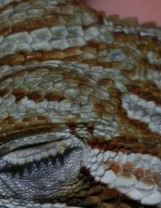Source: http://www.adambouskila.com/2007/06/02/things-to-consider-before-breeding-your-bearded-dragon/June 2, 2007
Things to Consider Before Breeding Your Bearded Dragon
Breeding can be very stressful and difficult on your dragons especially for your female. It is critical that you select strong, healthy adult females before even considering breeding your dragon. If your female is young, weak, or not sufficiently maintained during breeding, your eggs (and female) will suffer tremendously. Over-breeding will also decrease the life span of your female dragons and cause later clutches to be weaker and genetically more prone to diseases and shorter life spans.Another important aspect to consider before breeding is cost. Properly caring for hatchlings is a very time consuming and costly adventure. It can be very rewarding and a lot of fun to watch your babies hatch and grow up, but it’s not for everyone. If you do not already own the supplies you will need to breed your dragon, you’re looking at somewhat of a small investment to get everything together. Check below for a list of supplies at minimum you will need.
List of Items You Will Need to Breed Your Dragon
- Incubator: Many people use the chicken incubator model Hovabator. I have never personally used this incubator because I have heard from others that it is unreliable and at best acceptable. It is also rather small for the amount of eggs we produce here. We use a homemade incubator made out of an old freezer and a Helix Control Unit.
- Vermiculite & Egg Boxes: Vermiculite is used as a substrate to place your eggs in inside the incubator once they have been laid. You will need some kind of egg box to fill with vermiculite to place the eggs inside. We use plastic $1 shoe boxes you can find at Wal*Mart.
- Digital Thermometer: Digital thermometers are extremely important to help monitor the temperature inside the incubator. Overheating or exposure to low temperatures can cause the eggs to die and not hatch.
- Cages for Hatchlings: You will need some type of housing system to house all of your new hatchlings. They cannot be kept with their parents or larger dragons. Many people use 10 gallon aquariums to accomplish this. We recommend either building your own rack system or using large Rubbermaid containers built into a shelving system. You will need a lot of cages – the more hatchlings per cage the more likely nips will occur.
- Heat Bulbs: Some type of heating bulbs will be needed. You must provide a basking spot of around 115 degrees F on the warm end, and around 85 degrees F on the cool side. We use regular 75 watt house bulbs for our rack system and they work great.
- UVB Bulbs: It is very important that you have proper UVB lighting for your hatchlings. At this young age, they need as much access to UVB as possible due to their tremendous growth rate.
- Calcium & Vitamin Supplementation: Every day your hatchlings will need their crickets dusted with a high quality calcium supplementation. We use RepCal. You will also need to use a vitamin supplementation product once a week. We use Herptivite.
- Food: You will need a ton of crickets. Healthy hatchlings can eat 50 or more crickets a day each. You should also provide them with fresh greens and pellets at all times even though it may take several weeks for them to start eating them.
- Spray Bottle: It’s extremely important that you mist your hatchlings at least 3 times a day to keep them hydrated. Gently spray room temperature water on then in a fine mist. They will drink the water from their face and off of rocks, sticks, and cage walls.








 Beardie Stuff by BeardedDragon.org
Beardie Stuff by BeardedDragon.org HypoX Red Dragon
HypoX Red Dragon Yellow Red Desert
Yellow Red Desert Flamintiger
Flamintiger Redflame
Redflame HypoPastel
HypoPastel Yellow and Lavender
Yellow and Lavender Yellow Tangerine
Yellow Tangerine Sandfire Sunburst
Sandfire Sunburst
 Orange Red Sandfire
Orange Red Sandfire Mixed Batch
Mixed Batch

